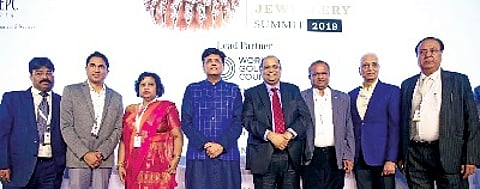

In an engaging and immersive topic on Financing the Gold Jewellery and Bullion Sectors, CNBC anchor Manisha Gupta asked some pointed questions to the eminent panelists. Regarding the fund crunch that the bullion trade was facing, PN Prasad, deputy managing director, Precious Metal, SBI, said, “The trust deficit in the last few years is one of the main reasons for not extending credit to the sector. The Ministry of Commerce had founded a coordinating committee to understand the problems, and we have arrived at a uniform policy, which will be adopted by all banks - one policy is for the gem and jewellery sector and the other, for the diamond sector.” Prasad also informed that a panel has been created, especially for valuation, and the team consisted of valuers from Customs and Excise departments.
The panellists including Nirakar Chand, CEO, DIL, Harish Madaan, head of treasury, ICBC, Manish Padhye, deputy general manager, ICICI Bank, Vipin Raina, presidentmarketing, MMTC-PAMP, Sabyasachi Ray, executive director, GJEPC, were of the view that offering metal gold loans would be an ideal way to align with the working capital cycle. One important differentiation in gold metal loans is that the interest rate is only 3-4%, while the interest rate for rupee loans is much higher. Chand was of the view that gold metal loans should be encouraged as they were a natural hedge against pricing. The positive framework, they believed, would bring back banks to offer fresh financing.
On the matter of there being less takers for funds, Ray informed that demand has dipped all over, and the cost of funds had gone up. He also highlighted the fact that way too many regulatory norms were proving to be a hurdle for ease of doing business or even getting gold metal funds.
Prasad commented that bullion should be viewed as an asset class. “I would say, at least 90 per cent of the companies are LLPs or corporates. On the parameter of transparency, as well,
the industry has transformed for the better. But more needs to be done to make this industry professional,” said Prasad.
The other important topic discussed was driving exports through technology and innovation. Moderator Shimul Vyas of National Institute of Design, Ahmedabad, set the backdrop for the conversation by talking about Gen Z, who don’t consider jewellery as an important category in their list of purchases. She remarked that the only way forward is innovation, which must be disruptive and transformative to capture this growing audience.
Tanmay Shah of Imaginarium said that in the new context, consumer should be put first on the list to check what they want before even designing a piece for them. Technology helps in the co-creation process between a customer and designer, who gets a free hand in expressing her ideas and innovating in the use of new materials. For retailers, the new-age technology helps them maintain a smaller inventory. “In a day and age when direct printing of 3D metals is possible, manufacturers can make on-demand jewellery,” he remarked.
Smrutiranjan Parida, metallurgy researcher, IIT, Mumbai, spoke about the development of new gold alloy that contained less gold, but had the same shine as the yellow metal. “The future lies in gold detection and standardisation parameters to accurately determine the fineness of gold, developing smart wearables like bracelets that monitor health, harvesting gold from e-waste, and more.”
David Bertazzo of SISMA, Italy, gave an educative talk on 3D-metal printing applications such as laser metal fusion and additive manufacturing to speed up the production development process.
Alparsian Misir of Alpress, Turkey, spoke about working closely with many Indian companies to make combination of fusion, casting, laser, and stamping machines to help make fusion jewellery, a specialty of India, in a quick and effective manner. “The company has also introduced laser colour marking that adds colour to a piece of jewellery in a short time with unbelievable precision”, he said.
Follow DiamondWorld on Instagram: @diamondworldnet
Follow DiamondWorld on Twitter: @diamondworldnet
Follow DiamondWorld on Facebook: @diamondworldnet
